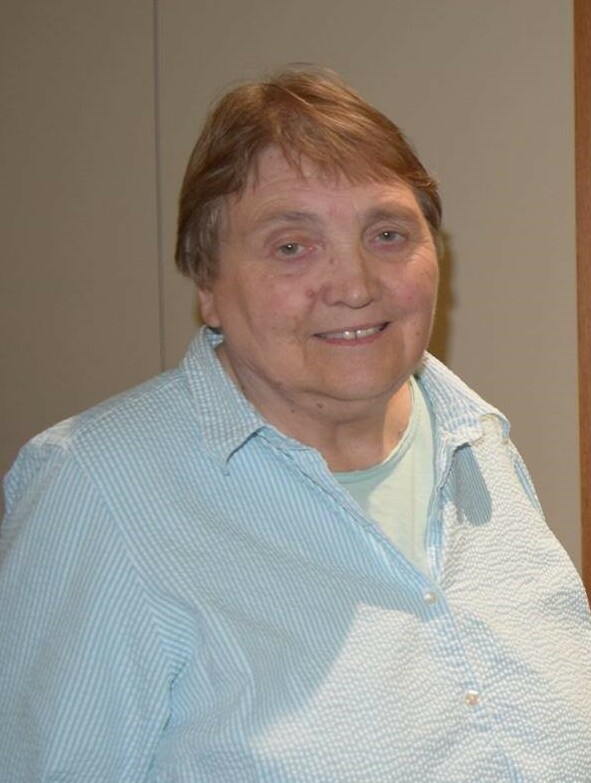





Obituary of Urve Linnamae
We lost a unique soul with the passing of Urve Linnamae on June 3, 2023 at the age of 83 at Royal University Hospital, Saskatoon. While Urve’s ill health was not a secret, it was still a shock to many that cancer took her so quickly. We were used to her rallying when life threw an obstacle in her way. This fight was sadly too much to overcome.
Urve was born to Minna and Aleksander Linnamӓe on March 27, 1940 in the village of Varbla, close to the west coast of Estonia. She was an only child. Unfortunately, her childhood there was interrupted by WWII and the rapid advance of Russian communists into the country. The communists were quickly shutting down all means of escape for Estonians trying to flee and they aggressively patrolled the offshore waters by submarine and aircraft, bombing refugee ships and small boats. Urve and her parents, along with others, including Minna’s siblings’ families, left on the very last day allowed by the communists which was September 21, 1944. Although they were stopped (and Urve recalled their safety and passage was secured by sacrificing a large cannister of syrup), the ship named “Navigator” made its way safely to Sweden. There, Urve’s father and other Estonians including boatbuilders, fishermen, mechanics ands seamen, purchased a 35m mine trawler which they refitted and renamed the “MV Pӓrnu”. The boat left Malmӧ, Sweden on July 17, 1949 carrying 154 people of which 54 were children such as Urve. They arrived in Halifax on August 2, 1949. Urve’s family moved to Winnipeg where they lived until 1953 at which point they moved to Toronto. It is important to note that Urve spoke no English when first arriving in Winnipeg yet in her later career she became a fearsome editor of the English language as many of her students can attest.
Urve enrolled at the University of Toronto where she completed her BA (Honours) in 1964 and her MA in Archaeology in 1966, both degrees obtained from the Anthropology Department at that institution. Archaeology was Urve’s chosen path and she pursued a Ph.D at the University of Calgary with successful completion of that degree in 1973, making her one of the first women to hold a PhD in Archaeology in Canada at that time. She was part of an illustrious cadre of archaeologists who emerged out of the new Archaeology program at the University of Calgary in the early 1970s who went on to assume faculty and museum positions across the country and mentor many of today’s practising archaeologists. Certainly, Urve was an important role model and mentor to many women archaeology students. She hired women as crew members when others would not (particularly true in the Arctic) and former female members of her projects credit her with their future professional careers in archaeology. She opened doors for many women in the field.
As a U of T student, Urve worked at the well-known Warminster site in Ontario, under the supervision of Norm Emerson. This site was assumed to be the Huron village visited by Champlain in 1615-16 and known to him as Cahiagué. She would have participated in other archaeological research around the southern Ontario region, often under the auspices of Emerson. It was, however, the Maritimes that would hold Urve’s interest for over a decade. In 1963 and until at least 1965 she participated in archaeological work at the huge early 19th century French fortified settlement in Nova Scotia known as Louisbourg (see photo description below and picture as you scroll through the obituary.)
Dr. Ralph and Urve Linnamae (seated) with the magnetometer in Louisbourg’s King's Bastion Chapel. Photo held by Parks Canada Agency and located online at https://beatoninstitute.com/g115. Photo dated August 28, 1963.
In the 1960s her attention was drawn to earlier indigenous settlements, particular those associated with the Dorset culture. Urve is recognized as being one of the first to investigate and recognize the distinctive regional diversity in Dorset archaeological assemblages in Newfoundland (Fogt 1998:3; Linnamae 1975; Wolff et al 2019:6). Her good friend Helen Devereux had investigated the Cape Ray site in 1964 to 1966 and the following two years Urve continued work at that important site in order to gather data for her Ph.D research (see image below). In 1967 she also spent time at the Fleur de Lys soapstone quarry and was the first to provide a metric description of it and to link its presence at other sites in Newfoundland such as Sop’s Island (Erwin 2001:42). Urve’s 1973 Ph.D dissertation, Dorset Culture in Newfoundland and the Arctic compared Dorset expressions in Newfoundland and the Arctic.
(see photo) The “Motley Crew”. Photo credit: Provincial Museum of Newfoundland and Labrador. Located on website https://nlarchsociety.ca/2021/03/05/women-in-nl-archaeology-helen-e-devereux/
In a complete break from her research in the Maritimes of Eastern Canada Urve participated in Scotty McNeish’s investigations into “Early Man” presence at Pikimachay Cave in the Ayacucho Basin, Peru, South America in 1969. A field season that resulted in a bad case of dysentery for Urve. In spite of that, this unique experience impressed itself on Urve and she recalled it with some pride.
A position in the Department of Anthropology and Archaeology at the University of Saskatchewan beginning in 1970 brought Urve to Saskatchewan, the province she would call home for the next 53 years. Over those years, she would inspire, mentor and befriend a long list of students who all continued on in archaeology, whether in CRM, government regulatory positions or academia. Although sometimes Urve could come across initially as a bit gruff and matter of fact, her students and others quickly learned that she had a kind and generous soul. And was an inveterate joke teller. As one of her longstanding friends recalled, Urve was a tough but outstanding woman.
Urve turned to Arctic archaeology between 1973 and 1976 at Rankin Inlet, a project promoted by Bob Williamson of the Institute of Northern Studies, University of Saskatchewan where Urve was now teaching. Williamson recognized that Rankin was an understudied area and that Urve would be a perfect candidate to lead the study. Brenda Clark, an early student and life-long friend of Urve’s, was part of that four-year study and commented that it was extremely unusual at that time to have a woman supervising a crew in archaeology in the Arctic. Brenda went on to produce a thesis in 1975 based on the results of the project. Pat Sutherland, Pamela Goshorn, Julia Harrison, Dale Russell and Don Gardner amongst others were participants in the project. Pat credits Urve with giving her the opportunity and experience to set out on her own successful career in Arctic archaeology. Urve’s work done at the Meiladine River on the west coast of Hudson Bay was significant in that the importance of the archaeological record there had not been previously recognized.
(see Photo) Crew at Rankin Inlet in 1975. From left to right: Urve Linnamae, Brenda Clark, Pat Sutherland (in front), Emil Daylight, Dale Russell. Urve’s dog Murri by her side. Photo from Urve’s personal collection.
A lovely outcome of Urve’s Rankin Inlet work which is illustrative of the impact the archaeological work had on the descendant community there was the decision by the Territory of Nunavut to create the Nunavut Territorial Park or Iqalugaarjuup Nunanga on the Meliadine River. Features located during the 19973-1976 project such as ancient tent rings, fox traps, winter and autumn house remains are included along the park’s interpretive trails. Clearly the work completed by Urve and also Brenda Clark was able to contribute to this celebration of the peoples’ ancestral ways.
In 1978 Parks Canada engaged the Environmental Division of the Saskatchewan Research Council to carry out an archaeological survey of the peninsula on the west side of the mouth of the Churchill River. Ft. Prince of Wales occupies the outermost point of this peninsula. Urve, with David Meyer, co-supervised this project and for over three weeks in August and they and crew recorded 18th and 19th century Inuit campsites in this area. These campsites had mainly been occupied by Inuit who were engaged by the Hudson’s Bay Company to hunt Beluga whales at the mouth of the Churchill River here.
While at the University of Saskatchewan, Urve turned her attention to plains archaeology and, along with her students, investigated such sites as the Coffin site (Linnamae 1995), Tschetter site (Linnamae 1988) and most importantly perhaps for her interest in lithic technology, the 9000-year-old Heron Eden Cody Complex site in southwestern Saskatchewan (Linnamae and Johnson 1999). In 1987 she conducted archaeological investigations on the Dakota Whitecap First Nation south of Saskatoon prior to construction of a proposed golf course and worked with a young, indigenous crew as well as with the assistance of archaeology students from the University of Saskatchewan. She also co-edited "Out of the Past: Sites, Digs and Artifacts in the Saskatoon Area" (Linnamae and Jones 1988) and contributed to other Saskatchewan archaeology compilations (Linnamae 1983; Linnamae et al 1988). Urve was the backbone of the Saskatoon Archaeological Society – the oldest avocational society in Canada - and was its treasurer for many years.
In retirement, Urve was most concerned that her collections and associated materials be housed in the appropriate facilities so future archaeologists would have access to them – an excellent example of how her professionalism so evident in her working life continued on in later years. With the help of David Meyer, these were eventually deposited in various museums, particularly the Canadian Museum of History in Ottawa.
As Urve began to consider retirement from the Department of Archaeology at the U of S (which occurred in 2003), she took a pragmatic approach to how her time and energies could be diverted to useful ends. Her first volunteer work was with the Friendship Inn which provides breakfast and lunch to those in need 365 days a year plus Thanksgiving and Christmas dinners. She dedicated many years there. But one could not attempt a personal history of Urve Linnamae without talking about cats. Urve contributed years of time, energy and considerable financial resources to Street Cat Rescue (SCAT) and the organization continues today because of her efforts. Before lack of mobility became a serious obstacle to Urve’s daily life, she was regularly travelling to the stables at Prairieland Park to replenish feeding stations for feral cats. It should be mentioned that Urve was no stranger to Prairieland and Marquis Downs as she loved horse racing and often spent an evening at the track in years past.
SCAT provided a social network of good friends for Urve, many of whom were of critical support to her in her last months. No doubt they would say that it was simply returning the support she provided to them for so many years.
So it is with great sadness but with good memories that we say goodbye to Urve Linnamae, masterful punster and joker (“I have socks older than you”), philanthropist to many charities and causes but particularly stray cats, mentor, archaeologist who contributed foundational knowledge to many aspects of Canadian archaeology but particularly Sub-Arctic and Arctic cultures, and most of all to so many, a good friend. That is perhaps her most lasting legacy – the wide range of people – the Estonian community in Saskatoon and across Canada, archaeologists and anthropologists, SCAT volunteers, neighbour friends and others who had the good luck to know Urve and join together now in celebrating her life.
Special condolences to Urve’s cousin in Estonia, Ilme Hõbemӓgi, and Ilme’s son Veikko as well to Urve’s friends in the Estonian community. Urve leaves behind her much cherished cat Rascal, now rehomed.
References Cited
Fogt, Lisa M.
1998 The Excavation and Analysis of a Dorset PaleoEskimo Dwelling at Cape Ray, Newfoundland. MA thesis, Dept. of Anthropology, Memorial University of Newfoundland, St. John’s.
Linnamae, Urve
1973 Dorset Culture in Newfoundland and the Arctic. PhD dissertation, Dept. of Archaeology, University of Calgary, Calgary.
1975 The Dorset Culture: A Comparative Study in Newfoundland and the Arctic. St. John’s Newfoundland Museum. Technical Papers of the Newfoundland Museum 1.
1983 Features and Their Use in Archaeology. In Tracking Ancient Hunters: Prehistoric Archaeology in Saskatchewan, H.T. Epp and I. Dyck (eds), Chapter 3, pp. 21-22.
1988 The Tschetter Site: A Prehistoric Bison Pound in the Parklands. In Out of the Past: Sites, Digs and Artifacts in the Saskatoon Area, Urve Linnamae and Tim E.H. Jones (eds), pp. 155-171. Saskatoon Archaeological Society.
1995 Stone Circles and Tipi Rings at the Coffin Site, Central Saskatchewan. Saskatoon Archaeological Society, Occasional Paper Number 1, pp. 1-71.
Linnamae, Urve and Eldon Johnson
1999 An Analysis of the Lithic Collection from the Heron Eden Site: A Cody Complex Manifestation in Saskatchewan. Saskatchewan Archaeology 20:14-32.
Linnamae, Urve and Tim E.H. Jones
1988 Out of the Past: Sites, Digs and Artifacts in the Saskatoon Area. Saskatoon Archaeological Society.
Linnamae, Urve, Ernest G. Walker and David L. Kelly
1988 A Summary of the Archaeology of the Saskatoon Area. In Out of the Past: Sites, Digs and Artifacts in the Saskatoon Area, Urve Linnamae and Tim E.H. Jones (eds), pp.155-171. Saskatoon Archaeological Society.
Wolff, Christopher B., Donald H. Holly, John C. Erwin, Tatiana Nomokonova and Lindsay Swinerton
2019 The Stock Cove Site: A Large Dorset Seal-Hunting Encampment
on the Coast of Southeastern Newfoundland on the Coast of Southeastern Newfoundland.
Anthropology Faculty Scholarship 18. https://scholarsarchive.library.albany.edu/cgi/viewcontent.cgi?article=1030&context=cas_anthro_scholar
This remembrance of Urve was compiled by Margaret Kennedy with much appreciated help from David Meyer, Marje Lepnurm, Bob McGhee, Pat Sutherland, Brenda Clark and Brenda Egilson.
Dependable. Committed. Compassionate.
We remain steadfastly committed to compassion, dignity, integrity and professional excellence.
Centrally located downtown at 4th Avenue and 25th Street Saskatoon Funeral Home can assist with a full range of services including pre-planning, traditional and non-traditional services for all faiths and philosophies, memorial services and complete assistance for unplanned circumstances such as a death occurring in a foreign country.
Looking for something you can't find? We make it easy to get the answers you need. Please feel free to contact our professional staff for any questions or to schedule an appointment with a Funeral Director at any time.




